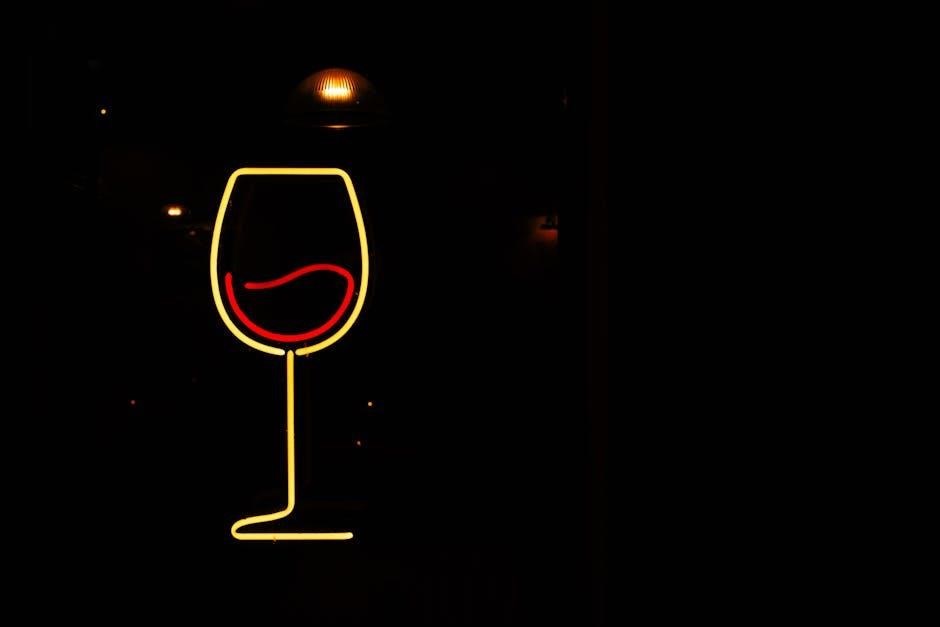Discover how the right wine glass enhances aroma‚ flavor‚ and overall enjoyment. This guide helps you navigate the world of wine glassware‚ ensuring perfect pairings for every sip.
Why Wine Glasses Matter
Wine glasses are more than just vessels; they enhance the aroma‚ flavor‚ and overall experience of wine. The shape‚ size‚ and material guide the wine to the right part of the palate‚ showcasing its unique characteristics. For instance‚ a Burgundy glass maximizes the complexity of Pinot Noir‚ while a Chardonnay glass highlights its buttery notes. Using the right glass ensures the wine’s bouquet and taste are fully expressed‚ making every sip more enjoyable. The debate over universal glasses continues‚ but many experts agree that specific designs elevate specific wines‚ proving that the right glass truly matters for a perfect tasting experience.
Key Features of Wine Glasses
The key features of wine glasses include the bowl shape‚ stem length‚ and base stability‚ which collectively enhance the wine-drinking experience. The bowl’s curvature directs wine to specific areas of the palate‚ optimizing flavor. A long‚ slender stem allows swirling without warming the wine with hand heat‚ while a sturdy base prevents tipping. Glass clarity and thinness are crucial for showcasing the wine’s color and aroma. Lead crystal‚ though more delicate‚ offers superior brilliance‚ while soda-lime glass is durable but less refined. These design elements ensure the glass complements the wine’s characteristics‚ making it an essential tool for wine appreciation.
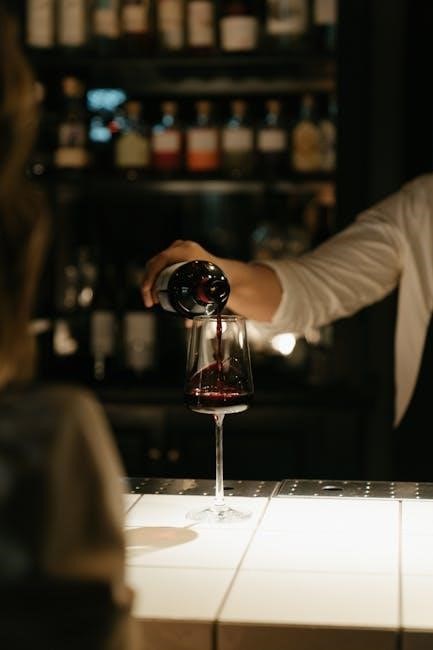
Understanding the Anatomy of a Wine Glass
A wine glass consists of a bowl‚ stem‚ and base‚ each designed to enhance aroma‚ flavor‚ and stability‚ ensuring an optimal wine-drinking experience.
Parts of a Wine Glass: Bowl‚ Stem‚ and Base
A wine glass is composed of three essential parts: the bowl‚ stem‚ and base. The bowl‚ the upper portion‚ is designed to cradle the wine‚ allowing it to breathe and release aromas. Its shape directs the wine to the appropriate part of the palate. The stem connects the bowl to the base‚ enabling swirling without spilling‚ while also preventing the hand from warming the wine. The base provides stability‚ balancing the glass securely. Together‚ these elements ensure optimal wine presentation‚ enhancing both flavor and aroma for a superior tasting experience.
How the Shape and Size Impact Wine Flavor
The shape and size of a wine glass significantly influence the flavor and aroma of wine. A larger bowl allows red wines to breathe‚ releasing bold flavors and tannins. Narrower bowls‚ ideal for white wines‚ preserve crispness and acidity by concentrating aromas. The rim’s width and shape direct the wine to specific areas of the tongue‚ enhancing sweetness or minerality. The glass’s capacity ensures proper aeration without overwhelming the senses. Thus‚ the design guides the wine’s interaction with air and the palate‚ optimizing the sensory experience and bringing out the wine’s unique characteristics.
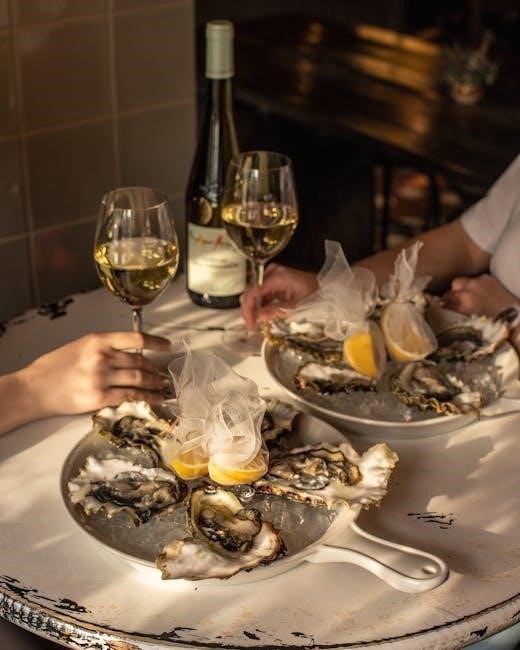
Types of Wine Glasses
Explore the variety of wine glasses designed for red‚ white‚ sparkling‚ and dessert wines‚ each crafted to enhance aroma‚ flavor‚ and overall drinking experience.
Red Wine Glasses
Red wine glasses are designed with a larger bowl to allow oxidation‚ enhancing the complex flavors of full-bodied wines like Cabernet Sauvignon and Syrah. The shape directs wine to the back of the palate‚ emphasizing bold tannins and fruit notes. The rim is often wider to release aromas‚ while the stem length varies for comfort; These glasses are tailored to showcase the richness and depth of red wines‚ ensuring an optimal drinking experience. Whether for a robust Merlot or a delicate Pinot Noir‚ the right red wine glass elevates the wine’s natural characteristics‚ making every sip more enjoyable and aromatic.
White Wine Glasses
White wine glasses are crafted with a smaller‚ narrower bowl to preserve delicate aromas and flavors. This design prevents excessive oxidation‚ maintaining the wine’s crispness and acidity. The narrower rim directs the wine to the front of the palate‚ enhancing the perception of fruitiness and floral notes. Ideal for lighter whites like Sauvignon Blanc or Pinot Grigio‚ these glasses are also suitable for richer varieties such as Chardonnay‚ especially when aged in oak. The shape and size ensure the wine’s subtle characteristics are highlighted‚ offering a balanced and refined tasting experience. Whether you prefer zesty or buttery whites‚ the right glass enhances the wine’s natural elegance and complexity.
Sparkling and Dessert Wine Glasses
Sparkling wine glasses‚ often called flutes‚ feature a tall‚ narrow bowl to preserve effervescence and direct the wine’s aromas upward. This design enhances the lively‚ refreshing qualities of Champagne and prosecco. Dessert wine glasses‚ in contrast‚ are smaller and more rounded‚ concentrating the sweet‚ complex aromas of ports‚ sherries‚ or Sauternes. Their shorter stems and wider mouths allow the rich‚ sugary notes to unfold without overwhelming the senses. Both styles are crafted to elevate the unique characteristics of their respective wines‚ ensuring a delightful and refined drinking experience for any occasion‚ from celebrations to indulgent desserts.
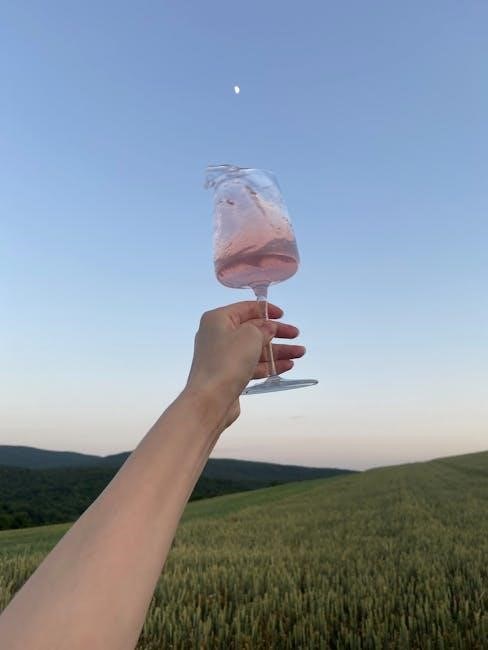
Material and Craftsmanship
Wine glass quality hinges on materials and craftsmanship. Lead crystal enhances clarity and durability‚ while soda-lime glass offers affordability and practicality‚ each shaping the wine-drinking experience uniquely.
Importance of Glass Quality
Glass quality significantly impacts the wine-drinking experience. High-quality materials‚ such as lead crystal or soda-lime glass‚ ensure clarity‚ durability‚ and proper aromas. Lead crystal enhances brilliance and refraction‚ while soda-lime glass offers affordability and practicality. A well-crafted glass preserves wine’s delicate flavors and aromas‚ making it essential for connoisseurs. Durable glassware withstands repeated use and cleaning‚ maintaining its elegance over time. Investing in quality glassware elevates both the visual and sensory enjoyment of wine‚ ensuring every sip is savored to its fullest potential.
Lead Crystal vs. Soda-Lime Glass
Lead crystal and soda-lime glass are two popular materials for wine glasses‚ each with unique characteristics. Lead crystal contains lead oxide‚ which increases brilliance and clarity‚ while soda-lime glass is more affordable and eco-friendly. Crystal’s higher density enhances aroma concentration‚ making it ideal for fine wines. Soda-lime glass‚ though less luxurious‚ is durable and suitable for everyday use. Both materials ensure a smooth sipping experience‚ but crystal’s aesthetic appeal and sensory benefits make it a preferred choice for special occasions. Choosing between them depends on personal preference‚ budget‚ and the type of wine being served.
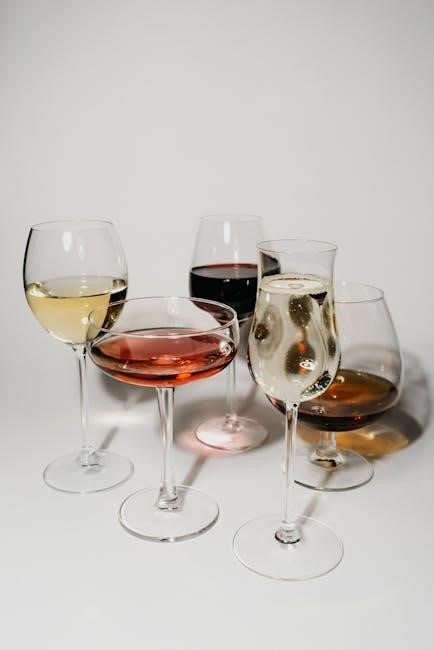
Choosing the Right Glass for Your Wine
Selecting the perfect glass for your wine enhances its flavor and aroma; This guide helps you match the right glass to your wine variety‚ ensuring optimal tasting experiences.
Matching the Glass to the Wine Variety
Choosing the right glass for your wine is crucial‚ as the shape and size significantly impact aroma and flavor. For red wines‚ a larger bowl allows oxidation‚ enhancing bold flavors. White wines benefit from smaller bowls that preserve delicate aromas. Sparkling wines require tall‚ narrow flutes to maintain effervescence. Understanding these nuances ensures optimal enjoyment. By pairing the glass to the wine variety‚ you enhance the tasting experience‚ allowing the wine to express its full potential. This guide helps you make informed decisions‚ ensuring every sip is perfected.
Universal Wine Glasses: Do They Work?
Universal wine glasses are designed to work for both red and white wines‚ offering simplicity for those who prefer not to own multiple sets. While they may not perfectly enhance specific varietals‚ they provide a balanced experience. These glasses typically feature a moderate bowl size and rim opening‚ making them versatile. They are ideal for casual drinkers or those with limited storage. However‚ they may not fully capture the nuances of complex wines like Burgundy or Champagne. Ultimately‚ universal glasses are a practical choice‚ delivering decent performance across various wines without the need for specialized glassware.
Care and Maintenance
Proper care involves washing glasses by hand with mild soap‚ avoiding abrasives‚ and storing them upright to prevent water spots and maintain clarity.
How to Clean and Store Wine Glasses
Proper cleaning and storage are essential for maintaining the clarity and integrity of your wine glasses. Use mild soap and warm water‚ avoiding abrasive materials that can scratch the glass. Rinse thoroughly and dry with a lint-free cloth to prevent water spots. For storage‚ keep glasses upright in a protected area to avoid dust accumulation and potential breakage. Regular polishing with a soft cloth can maintain brilliance. Avoid machine washing‚ as high heat and harsh detergents may damage the glass or affect its clarity. Proper care ensures your wine glasses continue to enhance your wine-drinking experience for years.
tips for Longevity
To ensure your wine glasses last‚ handle them with care. Avoid twisting or bending the stems‚ as this can cause stress fractures. Store glasses in a protective case or rack to prevent chips and breaks. When washing‚ use a soft cloth and mild detergent‚ avoiding abrasive materials that can scratch the surface. Never expose glasses to extreme temperature changes‚ such as moving them directly from a hot dishwasher to a cold surface. Regular polishing with a lint-free cloth can maintain clarity and prevent dust buildup. By following these tips‚ your wine glasses will remain pristine and continue to enhance your wine-drinking experience for years to come.

